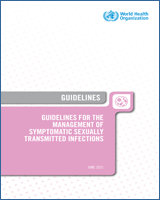Causative agents of pelvic inflammatory disease include N. gonorrhoeae, C. trachomatis and bacteria associated with bacterial vaginosis. Facultative gram-negative rods and mycoplasmas have also been implicated. Since differentiating between these clinically is impossible and precise microbiological diagnosis is difficult, the treatment regimens must be effective against this broad range of pathogens. The regimens recommended below are based on this principle.
9.1. Recommendations for the management of lower abdominal pain among women
View in own window
| For sexually active women with symptom of lower abdominal pain, WHO suggests assessing for pelvic inflammatory disease and treating syndromically. |
(Conditional recommendation; low-certainty evidence)
|
Good practice includes:
taking a medical and sexual history and assessing the risk of STIs; performing a physical examination, including abdominal and pelvic examination, to assess for pelvic inflammatory disease, surgical conditions or pregnancy and vulvovaginal examination to visualize any lesions, overt genital discharge, vulval erythema and excoriations; performing a bimanual digital examination of the vagina (1) to assess for cervical motion tenderness or pain with palpation of the pelvic area to exclude pelvic inflammatory disease; and (2) to assess for the presence of vaginal discharge and the colour and consistency of the discharge on the glove; and offering HIV and syphilis testing and other preventive services as recommended in other guidelines.
| Good practice statement |
For sexually active women with lower abdominal pain with either of the following features on clinical examination (bimanual palpation):
WHO suggests the following.
Treat for pelvic inflammatory disease on the same visit. Test for infection with N. gonorrhoeae and C. trachomatis and, if available, M. genitalium, to support partner management when tests are available. Schedule follow-up assessment three days later to assess for clinical improvement, and if the woman has not improved, refer for further assessment.
|
(Conditional recommendation; moderate-certainty evidence)
|
For women with lower abdominal pain with any of the following conditions, good practice includes referral to surgical or gynaecological assessment:
missed or overdue period; recent delivery, abortion or miscarriage; abdominal guarding and/or rebound tenderness; abnormal vaginal bleeding in excess of spotting; abdominal mass; and detection of a suspected cervical lesion.
| Good practice statement |
Flow chart for the management of lower abdominal pain. *to support partner notification. NG, N.gonorrhoeae; CT, C. trachomatis; MG, M. genitalium.
9.1.1. Evidence summary (Annex 5)
We conducted systematic reviews of the diagnostic accuracy of syndromic management strategies to detect STIs (supplementary materials – systematic review lower abdominal pain). To detect N. gonorrhoeae and C. trachomatis, the syndromic management approach based on lower abdominal pain has 30% sensitivity and 73% specificity (moderate-certainty evidence). The accuracy of various signs and symptoms has also been calculated in individual studies. In a study of 623 women suspected of pelvic inflammatory disease, the sensitivity and specificity of fever was 47% and 64%, vaginal discharge 7% and 24% and tenderness of pelvic organs on bimanual examination 99% and 0.007%, respectively. In addition, a large study of 651 women in the United States of America (PEACH study) using criteria similar to the previous WHO syndromic management flow chart showed 83% sensitivity and 22% specificity. This accuracy means that, in a population with 5% prevalence of pelvic inflammatory disease among women with lower abdominal pain, 74% of the women would be unnecessarily treated but only 1% would have pelvic inflammatory disease and be missed. Immediate treatment of an acute pelvic inflammatory disease can avert adverse serious consequences such as chronic pelvic pain, ectopic pregnancy and infertility (moderate-certainty evidence). Therefore, higher value was placed on missing no woman with pelvic inflammatory disease and moderate value (although less) was placed on reducing the risk of transmitting STIs to partners.
Managing people presenting with lower abdominal pain based on a syndromic approach results in moderate benefits and minor harm compared with treating everyone or no treatment. The syndromic approach is already in place in most countries and would therefore be feasible and acceptable. The Guideline Development Group agreed that it would likely not negatively affect equity (in some settings it may increase equity) and would incur negligible costs because of the low costs of assessment and treatment.
9.2. Treatment for people presenting with lower abdominal pain
If pelvic inflammatory disease is confirmed or suspected, the treatment options for managing the person as an outpatient are shown in .
Treatment options for pelvic inflammatory disease.
Hospitalization of people with acute pelvic inflammatory disease should be seriously considered under the following circumstances.
the diagnosis is uncertain;
surgical emergencies, such as appendicitis and ectopic pregnancy cannot be ruled out;
a pelvic abscess is suspected;
severe illness precludes management on an outpatient basis;
the person is pregnant;
the person is unable to follow or tolerate an outpatient regimen; or
the person has failed to respond to outpatient therapy.


